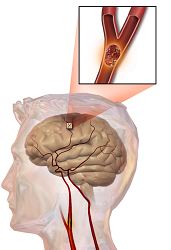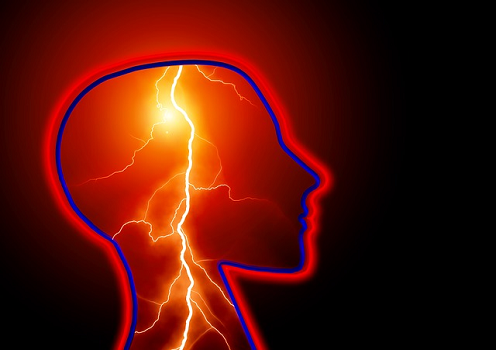You have created a character and breathed life into them in the pages of a story. Now you need to kill them off and have chosen stroke, but how do you make it realistic? What is it, how and what happens? How, why and when would your character die? What changes, if any, would you need to write into your doomed character?
Read on to find the answers these questions and help you kill your character with conviction.
For more information on the process of dying see ‘Killing your character with conviction – Staring Death in the Face’
What is a stroke?
Stroke is a ‘brain attack’ (once known as apoplexy), a disruption of the blood flow to the brain that causes pressure on the brain and loss of oxygen. Without oxygen the brain cells die and if the damage is severe enough, then it is fatal.
Fact: Stroke can affect the relatively young
Why your character dies
The brain is the control centre of the body sending informarion via electrical impulses on the nueral highway to the organs. Like all the organs of the body, the brain needs oxygen carried by the blood to function. If the blood flow is interrupted the brain stops functioning and causes a catastrophic breakdown in the other organs.
“A young Afro-American drug addict is at high risk of stroke”
More men have strokes than women, but more women die than men. Race also has an effect on risk. Native Americans, Asians, Hispanics and African Americans, more likely to be at risk, but the risk decreases with age. Caucasians are at a slightly lower risk, but the risk rises with age.
Abuse of drugs, in any age group, also increases the risk.
Your fated character is likely to be a woman, middle aged or older. An overweight diabetic with high blood pressure, who loves fryups, burger and chips, hates exercise, smokes, drinks, and suffers from palpitations and migraines.
Ischemic Stroke
This is the most common type of stroke and is caused by an artery in the brain being blocked by fatty deposits (Thrombotic) or a blood clot (Embolic). Blood clots can originate in the brain or travel in from another part of the body where blood has pooled as a side effect of another problem such as in the heart.
Hemorrhagic Stroke
This is a less common form of stroke caused by a burst blood vessel, but is responsible for more deaths. A blood vessel will burst when put under pressure and balloons (an aneurysm) as a result of either becoming tangled or high blood pressure.

Mini Stroke (Transient Ischemic Attack)
A mini stroke has all the same symptoms of a full blown stroke. The stroke may only last a minute, have no lasting damage and the symptoms not considered serious. They can, however, temporarily affect speech and sight. Your character may find themselves suddenly unable to understand or be lost for a word (Dysphasia), have blurred vision or be temporarily blind in one eye, made worse by bright light. The real danger is that mini strokes are often a warning of a major stroke in the future.
If the stroke happens on the left side of the brain, then the right side of the body will be affected.
The symptoms of a stroke are:
Asthenia (weakness in the arms or legs)
Facial Palsy (sloughing of one side)
Stiff neck
Confusion
Difficulty speaking (Dysphasia)
Difficulty seeing
Difficulty swallowing (Dysphagia)
Dizziness and loss of balance
Sever headache
The after effects of a stroke can range from none to a reduction or loss of mobility and other normal functions, which in turn can cause medical complications such as Pneumonia (see Killing your Character Convincingly – Pneumonia) or breathing problems. Other after effects and complications can be psychological or fatal.
Death is often not immediate, but happen within than the first month after the stroke. According to a study, most of the deaths were caused by another more serious stroke or heart disease. Having a stroke means your 8 times more likely of having another one.
Stroke can leave the person disabled and cause depression and so mean they are more likely to die from cancer, an accident or suicide.
“Death is often not immediate, but happen in the first month after a stroke”
After a stroke
A stroke can leave the brain damaged so the focus of after care is on various therapies, speech, occupational, recreational, rehabilitation and psychiactric. Perhaps the most interesting (in terms of a character) is PBA (Pseudobulbar Affect), the inapropriate emotional response to stimuli, related to depression. This can mean excessive and involuntary correct response, weeping or laughing inconsolably or becoming incredibly angry. Or an involuntary ‘wrong’ reponse, laughing at funerals etc.
My experience of PBA was a friend who had a stroke on her 30th birthday. It was actually in the toilet of a hotel, just after getting out of a hired limousine and before joining her guests for her party. She made a good recovery and apart from a weakness in her hand, had no physical after effects. The most striking effect was her lack of emotional connection. It was very much like living with a teenager, all those empathetic neurological connections, permanently disconnected.
THE END
All Rights Reserved
Image Attribute:
By Blausen Medical Communications, Inc. – Donated via OTRS, see ticket for details, CC BY 3.0, https://commons.wikimedia.org/w/index.php?curid=26986798
References :
Long-Term Survival and Causes of Death After Stroke – Henrik Brønnum-Hansen, Michael Davidsen, Per Thorvaldsen
and for the Danish MONICA Study Group
http: //hopeafterstroke.org/what-is-a-stroke-2/
http: //hopeafterstroke.org/post-stroke/
https://www.healthline.com/health/stroke/massive-stroke#risk-factors4
https://www.healthline.com/health/stroke/signs-symptoms-tia-mini-stroke#nbsp1
http: //hopeafterstroke.org/post-stroke/
http://www.strokeassociation.org/STROKEORG/LifeAfterStroke/RegainingIndependence/EmotionalBehavioralChallenges/Pseudobulbar-Affect-PBA_UCM_467457_Article.jsp#.WeuWpohrzIU

